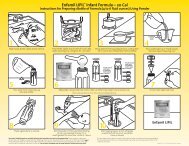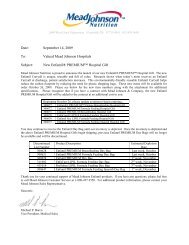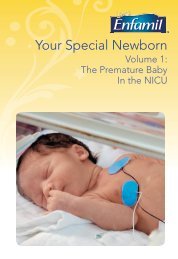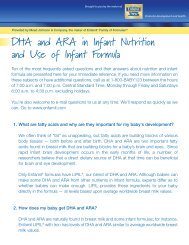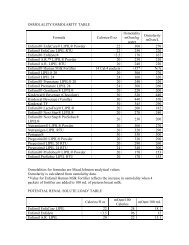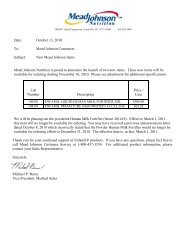You also want an ePaper? Increase the reach of your titles
YUMPU automatically turns print PDFs into web optimized ePapers that Google loves.
Preferred Provider Organizations (PPOs)PPOs are organizations that contract with healthcareproviders at a discount to provide services to theirbeneficiaries. Some PPOs are just contracting entitieswhile others contract with providers as well as processclaims, assume financial risk, market to employers, andperform various cost control functions.The coverage for enteral products in skilled nursingfacilities and homecare companies varies extensively <strong>by</strong>individual PPO. However, most PPOs will generally pay80% to 90% of preferred (those on contract) providercharges and 50% to 70% of non-preferred (those not oncontract) provider charges. Some PPOs charge the patienta co-payment amount, while others waive the co-paymentwhen preferred providers are used. You should consultwith the specific PPO for coverage criteria andreimbursement rates.Self-Insured Employers and Third PartyAdministrators (TPAs)A growing number of U.S. companies are becomingself-insured and are assuming the financial risk for theiremployees’ health benefits. About one-third of selfinsuredemployers are “self-administered,” meaning theydo their own provider contracting, cost containment, andclaims administration. The other two-thirds rely on a ThirdParty Administrator (TPA) to handle this function.Self-insured employers that are self-administered willdetermine the benefits for enteral nutrition products andservices, as well as review and pay covered claims. Selfinsuredemployers that use a TPA will rely on the TPA toadminister benefits to employees.COST CONTAINMENT MECHANISMSThere are a number of different cost containmentmechanisms in managed care. Those that affect thereimbursement of enteral products are reviewed in thefollowing section.Pretreatment Review (Precertification)Pretreatment review programs, sometimes called“precertification” or “precert” programs, are now acommon component of “managed” insurance plans. Withpretreatment review, either the patient or the provider mustcall an 800 number to request authorization for theplanned service. These programs may be patient-driven,meaning the patient is supposed to call the reviewprogram, which then contacts the provider, or providerdrivenmeaning the patient gives the insurance card withthe review program phone number to the provider so thatthe provider can call the review program.In precertification programs, nurses review themedical necessity of the proposed treatment, using criteriawhich vary from one review program to another. Thesenurses usually have access to physician consultants forreview of more complex cases. The review programpersonnel may work for an insurer, HMO, PPO, ThirdParty Administrator (TPA), or for a separate utilizationreview company under contract to one of these payers.Precertification programs also differ with respect towhich entity bears the financial burden of compliancewith the review program. In a managed insurance plan,the patient is typically at risk for having the carereimbursed at a 10% to 30% lower rate if pretreatment is<strong>by</strong>passed. In PPOs or HMOs, the compliance burdenmore often resides with the provider. The penalty for noncompliancecan range from reimbursement at a lowerrate, to a “black mark” on the provider’s utilizationreview profile, to denial of reimbursement for the serviceprovided without authorization.The list of services that require pretreatment reviewvaries widely among insurers’ plans. Almost all programsrequire review of hospital admissions. Most requirereview of significant outpatient surgeries or procedures.Policies on skilled nursing facility, homecare and otherancillary services vary widely. The safest practice for anyprovider or patient is to call the review program 800number and check on the review program’s policies.One aspect of preauthorization review programs thatcan confuse providers and lead to unpaid claims is theissue of exactly what it means when a proposed service is“precertified” or “preauthorized.” Most programs areresponsible only for determining that the proposed servicemeets medical necessity guidelines based on theinformation they were given during the request forauthorization. Reimbursement may still be denied evenwhen preauthorization has been obtained for one or moreof the following reasons:May, 2002 7❏❏The patient is not covered <strong>by</strong> the insurance planat the time the service is providedThe service provided is not covered under thebenefit plan❏ The patient has exhausted the relevant benefitsavailable under their insurance❏ The patient’s condition changed afterpreauthorization was obtained, making theservices no longer medically necessary in thereview programs’ judgment❏ Information provided during the preauthorizationrequest is subsequently determined to besubstantially inaccurate or incomplete leading toa different conclusion as to the medical necessityof the serviceThe same office that handles preauthorization mayalso verify eligibility and benefits for the proposedservice, but more often this is a different department.Sometimes skilled nursing facility or homecare servicescan be authorized and paid for even when the patient’sbenefit plan does not cover the proposed service or whenbenefits for these services have been exhausted. If theseservices are not provided in a benefit plan and the patientwould require more expensive inpatient or outpatienthospital services, the review program may, nevertheless,approve and agree to pay for these services. The reviewprograms case management department usually handlesconsideration for such exceptions.







